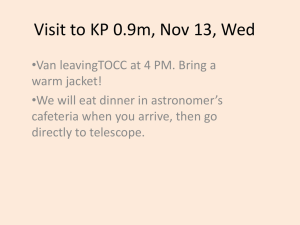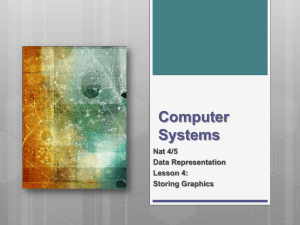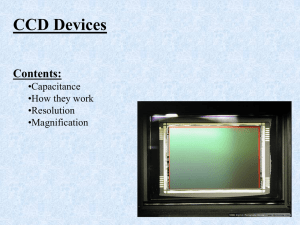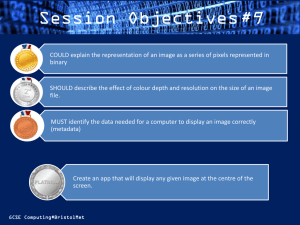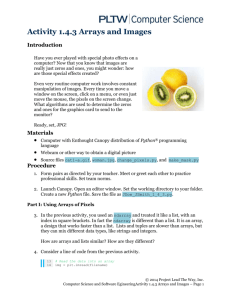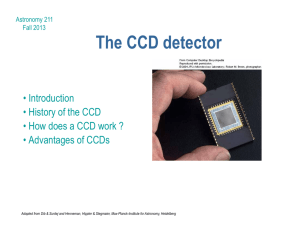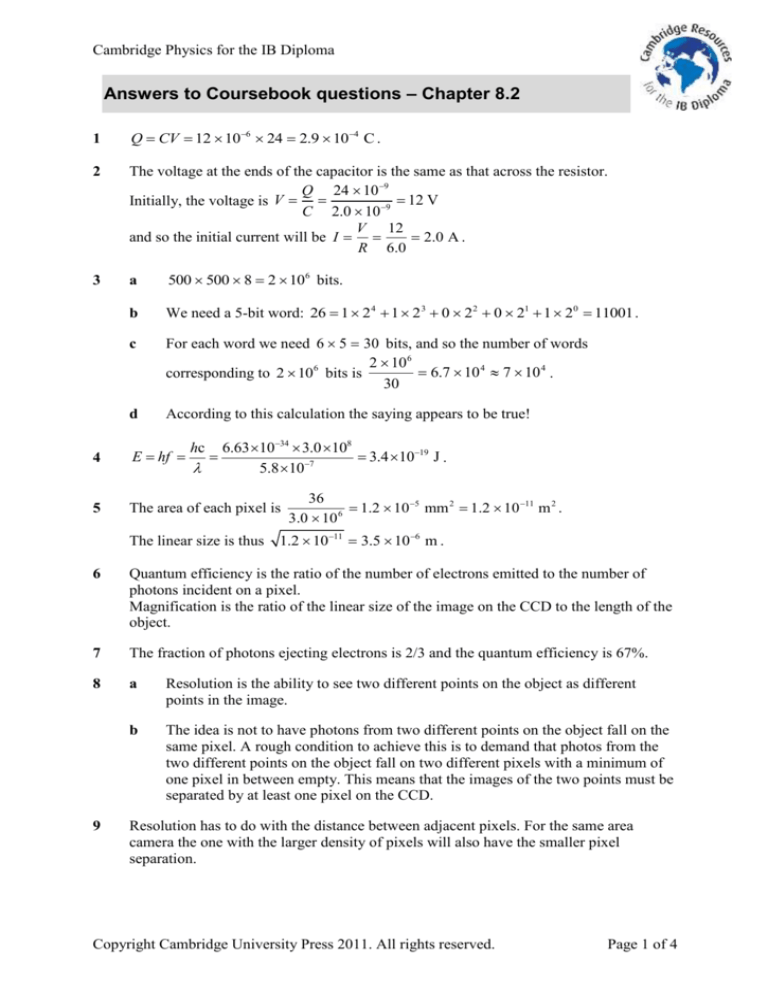
Cambridge Physics for the IB Diploma
Answers to Coursebook questions – Chapter 8.2
1
Q CV 12 10 6 24 2.9 104 C .
2
The voltage at the ends of the capacitor is the same as that across the resistor.
Q 24 10 9
12 V
Initially, the voltage is V
C 2.0 10 9
V 12
and so the initial current will be I
2.0 A .
R 6.0
3
a
500 500 8 2 106 bits.
b
We need a 5-bit word: 26 1 2 4 1 2 3 0 22 0 21 1 20 11001 .
c
For each word we need 6 5 30 bits, and so the number of words
2 10 6
6.7 10 4 7 10 4 .
corresponding to 2 106 bits is
30
d
According to this calculation the saying appears to be true!
hc
E hf
5
The area of each pixel is
6.63 1034 3.0 108
3.4 1019 J .
7
5.8 10
4
36
1.2 10 5 mm 2 1.2 10 11 m 2 .
3.0 10 6
The linear size is thus 1.2 10 11 3.5 10 6 m .
6
Quantum efficiency is the ratio of the number of electrons emitted to the number of
photons incident on a pixel.
Magnification is the ratio of the linear size of the image on the CCD to the length of the
object.
7
The fraction of photons ejecting electrons is 2/3 and the quantum efficiency is 67%.
8
a
Resolution is the ability to see two different points on the object as different
points in the image.
b
The idea is not to have photons from two different points on the object fall on the
same pixel. A rough condition to achieve this is to demand that photos from the
two different points on the object fall on two different pixels with a minimum of
one pixel in between empty. This means that the images of the two points must be
separated by at least one pixel on the CCD.
9
Resolution has to do with the distance between adjacent pixels. For the same area
camera the one with the larger density of pixels will also have the smaller pixel
separation.
Copyright Cambridge University Press 2011. All rights reserved.
Page 1 of 4
Cambridge Physics for the IB Diploma
10
A digital camera (for personal use or cameras on telescopes and space-based
telescopes), video camera, a copier, a scanner, a fax machine and X-ray
detectors for medical uses.
11
Light incident on the collecting area of the CCD causes electrons to be ejected from
each pixel (by a process similar to the photoelectric effect), and hence a potential
difference is established at the ends of each pixel. The potential difference is
proportional to the charge in each pixel and that in turn is proportional to the intensity
of light in each pixel. The potential difference is read sequentially, row by row and its
value is first converted into binary (digital) form along with the position of each pixel.
Knowing the position of each pixel and the intensity of light in each allows the
construction of an image.
12
The large difference in the number of pixels means that the 8 megapixel camera
consists of smaller pixels and so the separation of pixels is much smaller. This means
that this camera will have a better resolution, i.e. much finer detail in the images will be
possible.
13
The advantage of higher quantum efficiency is that a shorter exposure time will be
required.
14
There will not be any difference in the two images. The advantage of a larger collecting
area is that a larger area can be imaged.
15
The ratio of the areas of image to object is
16
The distance between the images of the two points will be
8.2 10 4 1.3 1.07 10 3 mm .
16
4.0 10 6 mm 2
The area of one pixel is
6
4.0 10
9.4 10 6
1.516 .
6.2 10 6
The magnification is the ratio of the linear size of the image to that of the object and is
thus 1.516 1.23 1.2 .
and its linear size is 4.0 10 6 2.0 10 3 mm .
The distance between the images is less than two pixel sizes and so the images cannot
be resolved.
17
a
In 1 second the power incident on a unit area (1 square metre) is 28 J.
hc 6.63 1034 3.0 108
2.9 1019 J
The energy of one photon is E hf
7
6.8 10
28
9.7 1019 .
and so the number of photons per unit time per unit area is
2.9 10 19
b
These photons have more energy and so fewer of them are required.
4.4
6.3 1019 .
Their number will be 9.7 1019
6.8
Copyright Cambridge University Press 2011. All rights reserved.
Page 2 of 4
Cambridge Physics for the IB Diploma
18
19
a
The energy of one photon is
hc 6.63 1034 3.0 108
E hf
4.111019 J and so the energy of
4.8 107
6000 of them is 6000 4.11 1019 2.47 1015 J .
The energy given to the pixel is
1.4 103 5.0 1010 t 2.47 1015 t 3.5 ms .
b
The quantum efficiency of the camera cannot be 100% and so not all of the 600
photons will be absorbed. Therefore, to get an acceptable image a longer time
must be used to allow for more photons to be incident on the pixels.
48
1.2 10 5 mm 2 1.2 10 11 m 2 .
6
4.0 10
hc 6.63 1034 3.0 108
3.16 1019 J .
The energy of one photon is E hf
7
6.3 10
The energy deposited in the pixel in 80 ms by N photons is thus
N 3.16 1019 5.2 103 1.2 1011 80 103 and so N 2.8 10 4 .
Since the QE is 0.75 the number of electrons ejected in one pixel is
N 0.75 2.8 10 4 2.1 10 4
and hence the electric charge developed is 2.1 10 4 1.6 1019 3.36 1015 C .
The area of one pixel is
Hence the voltage is V
20
Q 3.36 1015
1.4 104 V .
12
C
24 10
The charge that develops in each row of pixels must be read and recorded. This is done
by sequentially moving the charge in each row to the row below and the charge in the
very last row to the register where it is measured. Thus the charge in each row is
connected, i.e. coupled to that in the row below.
21
5.0 10 3
1.4 10 3 .
The number is
3.65
22
Advantages include:
The image is digital and so can be edited/manipulated/electronically transported.
Many more images may be stored in a digital camera than on film.
The response of the CCD is uniform over a wide range of wavelengths (i.e. the
number of electrons ejected is the same for the same number of photons of
different wavelengths).
The response of the CCD is fairly linear, which means that the number of
electrons ejected is proportional to the intensity of light. Faint as well as bright
objects can appear on the same image.
The noise is very limited, i.e. there is little charge created in the pixels whose
origin is other than light incident on the pixel.
Copyright Cambridge University Press 2011. All rights reserved.
Page 3 of 4
Cambridge Physics for the IB Diploma
23
At higher temperatures there is considerable thermal motion of electrons.
(Recall that temperature is proportional to the average random kinetic energy of
molecules but also of electrons.) Hence at higher temperatures electrons may be
ejected from the pixels and contribute to the potential difference at the ends of the
pixels even when no light falls on the pixels. Lowering the temperature prevents that to
a considerable degree.
24
The most important characteristic is the ability of the CCD to create at the same time an
accurate image of a very faint and a very bright object. With photographic film the
fainter image tends to wash out. Further, since the image is in digital form it can be
easily processed and analysed using various kinds of software. Finally, their small size
allows their placement in spacecraft or orbiting stations. The digital nature of the image
then allows the image to be sent down to earth.
25
It can be used to record X-rays with an exposure time that is much less than the
conventional method using film. The short exposure time limits the radiation delivered
to the patient.
Copyright Cambridge University Press 2011. All rights reserved.
Page 4 of 4



